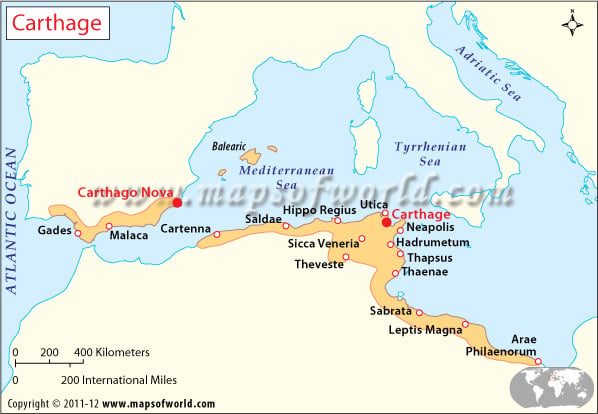Timaeus, an ancient Greek historian, believed that the civilization in Carthage was founded in around 814 BC. Although archaeologists once believed that the civilization that centered on this Tunisian city-state was younger, it has now been satisfactorily dated to the late ninth century BC.
Carthage, in northern Tunisia, was founded by Phoenicians from Tyre. By the sixth century BC, Carthage had become a trading hub and the commercial center of the western Mediterranean region. By 575 BC, when King Nebuchadnezzar II of Babylonia had taken over Tyre, Carthage emerged as the center of an empire that spanned across the Mediterranean coastal region and Sicily.
Carthage – Trade Hub of the Mediterranean
Carthage was a strategic trading center, and the gold trade flourished in this Tunisian town. The city had two excellent harbors, which formed the backbone of the maritime supremacy that Carthage enjoyed. Punic beds and bedding were highly coveted in Rome and other neighboring regions. Other merchandise exported from Carthage and traded across the sea included ivory, ceramics, spices, fruits, edible nuts, glassware, and jewelry.
The Legend of Elissa
Legend has it that Carthage was founded by Elissa (referred to as Dido in many accounts), the princess of Tyre. Elissa married Acerbas, a wealthy priest. When Acerbas was murdered by her brother, King Pygmalion, Elissa fled to Northern Africa to escape with her life. There she built the city of Carthage with help from the locals. When the city became a prosperous center, Elissa committed suicide at a pyre to escape marrying Maxitani, a local king. Elissa was worshipped by Carthaginians as the goddess who founded their city. The legend turns out to be historically accurate in many respects. The Roman poet Virgil recorded his version of the legend in the Aeneid.
Punic Wars
The three Roman-Carthaginian wars fought between 264 BC and 146 BC were known as the Punic Wars. The conflict between the Carthaginian and Roman empires arose primarily over Sicily. The Carthaginian Empire was a major power in the western Mediterranean regions. Italy, though not quite as powerful a maritime empire, was on an expansion mission, and Sicily offered it the strategic and cultural clout required to become a superpower.
The First Punic War lasted from 264 BC to 241 BC. The costly war ended in a defeat for the Carthaginians who relinquished Sicily. In the Second Punic War (218 BC-201 BC),
Carthage was represented by one of the most able military commanders of the ancient world, Hannibal Barca. In a daring move, Hannibal crossed the Alps and defeated the Romans in Italy. Other battles fought in Hispania did not yield much success and the Carthaginians were finally defeated in the Battle of Zama in Africa. By the end of the Second Punic War, the Carthaginian Empire had dwindled, and the city alone represented the erstwhile empire.
The Third Punic War was fought between 149 BC and 146 BC. Carthage’s developing economic conditions and anti-Roman sentiments alarmed the Romans, who laid siege to the city. The war ended in 146 BC with the complete annihilation of Carthage and its inhabitants.

 Archaic Greece
Archaic Greece